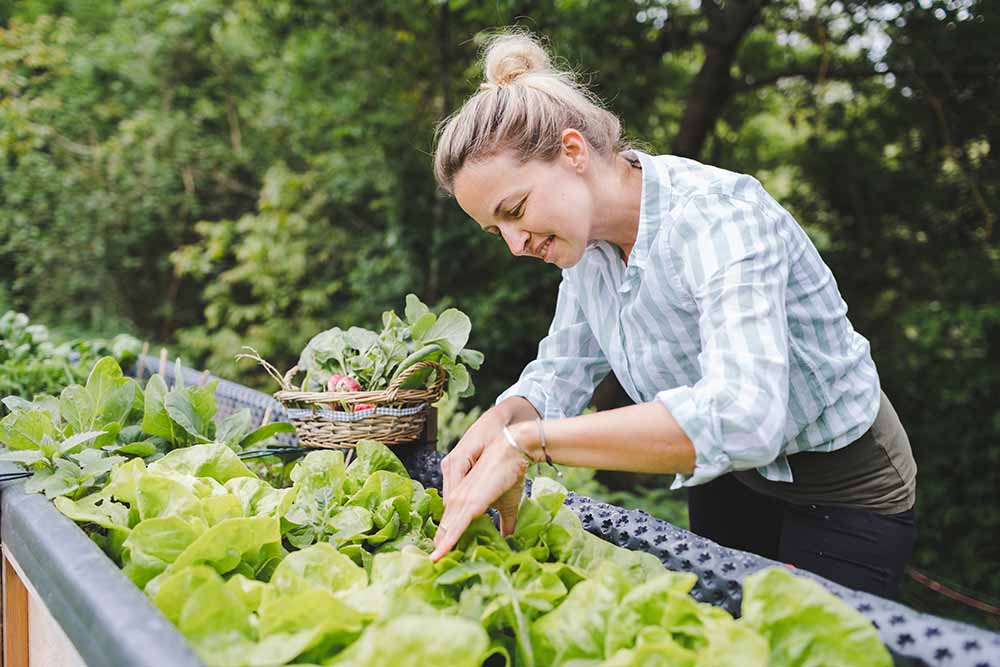
Have you ever had a tomato or cucumber fresh from someone’s garden and wished you had your own little plot of home-grown vegetables? For some reason, veggies from the garden seem to taste so much better than the ones at the grocery store. So why not try growing your own?
Sure, having a vegetable garden sounds intimidating, but with a bit of work and patience, you too can have delicious tomatoes right off the vine. Here’s how to get started growing your own vegetables in 5 easy steps.
Step 1: Pick the right spot Step 2: Choose the size of your garden (and start small) Step 3: Choosing your vegetables Step 4: Figure out when to plant Step 5: Care for your vegetable plants
Step 1: Pick the right spot
Just like flowers, vegetables will need a location that meets several different needs. The first thing to be aware of is sunlight. Most vegetables need a good amount of direct sunlight per day to grow properly, but there are some that like more shade.
Next up is water drainage. You want good soil that the water can easily pass through. If the water just sits in the bottom, then you risk root rot. Similarly, you want your soil to be consistent and not filled with rocks, which can make it harder for the roots of the plants to grow, leading to weaker vegetables. The soil also needs to be nutrient-rich, so make sure to prepare your soil accordingly.
Finally, be mindful of the wind. A vegetable garden in a windy area will struggle to grow properly. Not only can the wind knock over or damage the vegetable plants, but you also want to ensure that pollinating insects can easily access the plants without being blown away.
Step 2: Choose the size of your garden (and start small)
It’s easy to get excited about the idea of growing your own vegetables and wanting to plant lots of things all at once. But that can be overwhelming - not only do you need to care for these plants, but remember, the goal is to eat them. With a large garden, you might end up with too many vegetables at once, which can lead to food waste. Starting small is your best bet for a successful garden that you can keep up with. If you are planting in a raised bed, 4’x4’ or 4’x8’ are good sizes to get you started. Once you see how much you can grow with that space, you can decide if you want to enlarge it or add another one.
Step 3: Choosing your vegetables
If you are starting your first vegetable garden, you want to make it as simple as possible, so start with plants that fall on the easy list. This includes things like green beans, tomatoes, radishes, lettuce, peppers, beets, zucchini, carrots, and peas.
When choosing your vegetables, you should also speak to some gardening or farming experts in the neighbourhood to know what is most likely to grow successfully in your area. As for the number of plants you get, be realistic and choose only what you need to feed your family to get started. You can always add more later if things are going well. Don’t forget to buy high-quality seeds!
Step 4: Figure out when to plant
Vegetables, like flowers, can’t always be planted at any time of the year. Even then, different vegetables thrive at different times of the year. For example, tomatoes and peppers shouldn’t be planted until late spring or early summer, when the soil is warm. However, veggies like broccoli and peas grow best in the cooler weather of spring and fall.
You also need to consider the harvest season. Some vegetables grow rather quickly, while others will take a while to mature. Do your research and stagger your planting accordingly. You probably don’t want all your vegetables to be ready at the same time!
Step 5: Care for your vegetable plants
Once you have chosen what you want to plant, picked the right garden space, and planted the seeds, the job isn’t done. You still need to care for your vegetables. This means watering them as needed (remember, this can vary from plant to plant). You also want to keep an eye out for any signs of problems with the plant, such as issues with growing or any pests and diseases. Plus, be sure to do whatever you can to discourage weed growth and keep any hungry animals out.
Final tip: remember that unlike herbs and fruits, many vegetables are perennials, not annuals. Of course, there are some annual vegetable plants as well, but it’s up to you to know what will only last a single season versus what will grow back next year.
Growing your garden can be a lot of work and will take some careful planning to get started. However, once you have the hang of it, you’ll be amazed about how many of your own vegetables you can grow.
Hannah Logan is a Canadian travel writer who dreams of being just like Indiana Jones. You can follow her travels on her personal travel blog
Eat Sleep Breathe Travel where she shares her travel tales and (mis)adventures around the world.